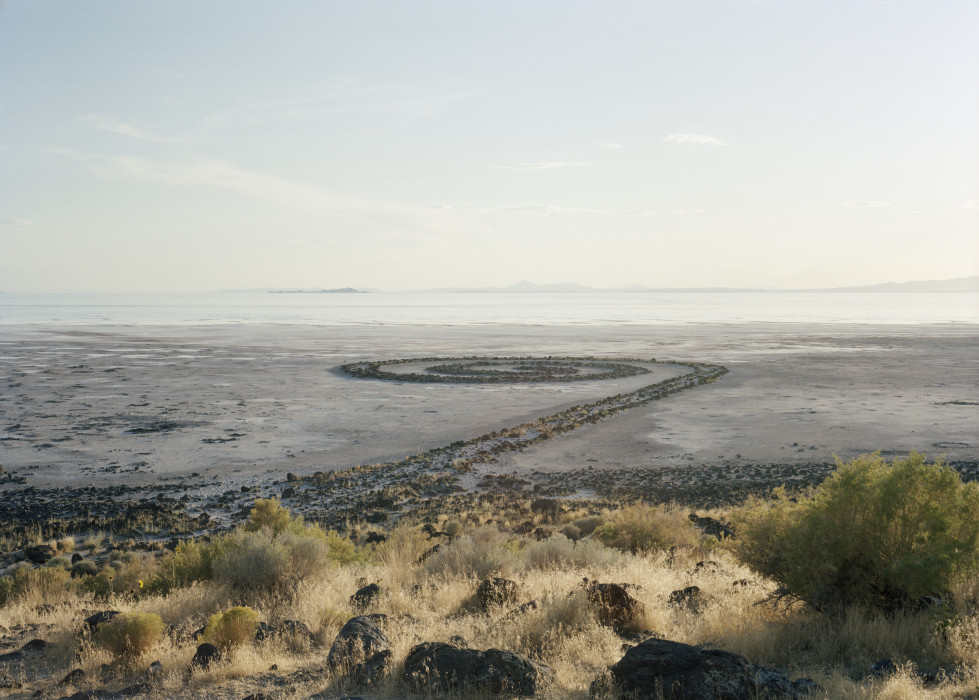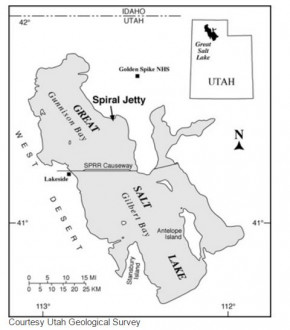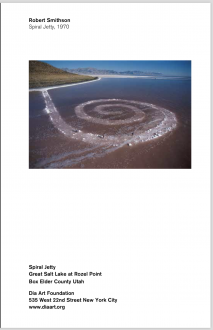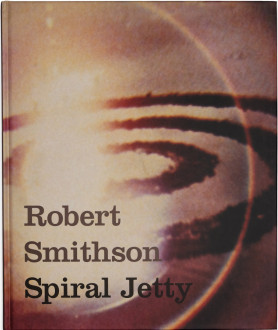Robert Smithson, Spiral Jetty | Visit Our Locations & Sites Visit Dia (original) (raw)
Great Salt Lake, Utah

Robert Smithson, Spiral Jetty (1970), 2019. © Holt/Smithson Foundation and Dia Art Foundation/Licensed by VAGA at Artists Rights Society (ARS), New York. Photo: Victoria Sambunaris
Overview
Robert Smithson's earthwork Spiral Jetty (1970) is located at Rozel Point peninsula on the northeastern shore of Great Salt Lake. Using over six thousand tons of black basalt rocks and earth from the site, Smithson formed a coil 1,500 feet long and 15 feet wide that winds counterclockwise off the shore into the water. In 1999, through the generosity of the artist Nancy Holt, Smithson’s wife, and the Estate of Robert Smithson, the artwork was donated to Dia Art Foundation.
Dia is proud to be the owner and steward of Robert Smithson’s Spiral Jetty. We rely on your help to preserve the artwork for all of us now and for future generations.
Please leave Spiral Jetty and the natural environment exactly as you found it.
Visitors must “leave no trace” at the site. Do not take existing rocks from the artwork or trample vegetation. Making fire pits near the artwork or on the parking lot is strictly prohibited and will result in significant fines. Carry out any waste with you.
Robert Smithson’s Spiral Jetty, located at Rozel Point on the northeastern shore of Great Salt Lake in Utah, is one of the most remarkable examples of Land art. In 1970, assisted by a crew operating dump trucks, a tractor, and a front loader, Smithson displaced some 6,000 tons of black basalt rock and earth from the adjacent shore to form a coil 1,500 feet long and approximately 15 feet wide, winding counterclockwise into the lake. Created at a time when water levels were particularly low, Spiral Jetty was submerged in 1972. Droughts caused the lake to recede in 2002, and the sculpture has remained visible ever since.
“I like landscapes that suggest prehistory,”1 Smithson once observed. The site of Spiral Jetty was chosen by the artist for the lake’s unusual ecological and geological properties. The reddish coloration of the water, caused by the high presence of microbes, initially attracted Smithson to the north arm of the lake. The spiral shape alludes to the molecular lattice of the salt-crystal deposits found throughout the lake’s expanse, and in forming the work, he chose to use basalt boulders of hardened lava found along the peninsula, scattered remnants of the now extinct volcanos in the area.
The fractured landscape, fluctuating water levels, and the water’s salinity also speak of the artist’s preoccupation with the concept of entropy. Smithson envisioned an artwork in a state of constant transformation whose form is never fixed and undergoes decay from the moment of its creation. His thinking was equally shaped by his understanding of the third law of thermodynamics as well as a fascination in science fiction and popular science.
As a path for walking and looking, Spiral Jetty is a sculpture to be experienced. The act of traversing the earthwork is a prominent image in the eponymous film completed months after Smithson built the sculpture. Along with aerial shots of Spiral Jetty is a sequence of images of the artist running on the sculpture. Reaching the innermost point, Smithson gazes out at the spiral path, lake, and mountains. Spiral Jetty serves as a site from which to view the surroundings—the prehistoric environment that Smithson selected for it.
notes
1 Robert Smithson, “Conversation in Salt Lake City (1972),” in Robert Smithson: Collected Writings, ed. Jack Flam (Berkeley: University of California Press, 1996), p. 298.
Robert Smithson's earthwork Spiral Jetty (1970) is located at Rozel Point peninsula on the northeastern shore of Great Salt Lake. Using over six thousand tons of black basalt rocks and earth from the site, Smithson formed a coil 1,500 feet long and 15 feet wide that winds counterclockwise off the shore into the water. In 1999, through the generosity of the artist Nancy Holt, Smithson’s wife, and the Estate of Robert Smithson, the artwork was donated to Dia Art Foundation.
As stewards of Smithson’s Spiral Jetty, Dia has recorded changes to the work over time through annual photographic documentation since 2012. Water levels in the Great Salt Lake have changed throughout the years, both submerging and exposing the work, but the sculpture has remained visible since 2002. The Great Salt Lake, which once covered the work, is now almost one mile from the Spiral Jetty.
Dia is pleased to share this film highlighting Spiral Jetty and the work of Robert Smithson in celebration of our 50th anniversary.
Support provided by Bloomberg Philanthropies
Video by SandenWolff
Interviews: Rachel Wolff and Jonathan Sanden
Story editing: Rachel Wolff
Filming: Noah Therrien and Jonathan Sanden
Video editing: Stephen Parnigoni
Original Music: Noah Therrien
Additional music: roeaudionews, courtesy of Jamendo
Dia Art Foundation staff
Producers: Katherine Ellis and Dan Wolfe
Production assistant: Claire O’Neill
Rights and reproductions: Jenn Kane
Communications director: Hannah Gompertz
Copy editor: Anya Szykitka
Proofreader: Karen Rasaby
Special thanks to Lisa Le Feuvre, William T. Carson, and the Holt/Smithson Foundation
Additional thanks to Gretchen Dietrich and the Utah Museum of Fine Arts, and to Bonnie Baxter and the Great Salt Lake Institute
© 2024 Dia Art Foundation
All works © 2024 Holt/Smithson Foundation / Licensed Artists Rights Society (ARS), New York, unless otherwise noted
Dia partners with Great Salt Lake Institute at Westminster College, Holt/Smithson Foundation, and the Utah Museum of Fine Arts at the University of Utah to further advocate for Spiral Jetty.
Great Salt Lake Institute, Westminster College
Utah Museum of Fine Arts, University of Utah
The Division of Forestry, Fire, and State Lands within the State of Utah’s Department of Natural Resources oversees the lakebed where Spiral Jetty is located.
Department of Natural Resources
As stewards of Spiral Jetty, Dia is committed to recording changes to the work over time through photographic documentation. Since 2012, a geospatial aerial photographer has documented Spiral Jetty once or twice annually in the Spring and/or Fall.
Spiral Jetty Aerial Documentation
Photographic and video material of Spiral Jetty is copyright protected. For rights and reproduction requests, contact rights@diaart.org.
Visitor Information
Dia is proud to be the owner and steward of Robert Smithson’s Spiral Jetty. We rely on your help to preserve the artwork for all of us now and for future generations.
Please leave Spiral Jetty and the natural environment exactly as you found it. Visitors must “leave no trace” at the site. Carry out any waste with you. Do not take existing rocks from the artwork, make fire pits, or trample vegetation.
Guests are advised to bring water, food, and waterproof boots, along with weather-appropriate clothing. There are no bathrooms, food, fresh water, nor fuel at the site. Drinking water and bathrooms can be found en route to Spiral Jetty at the Golden Spike National Historic Site Visitor Center.
Due to a local drought, Spiral Jetty is currently completely visible.
For general inquiries related to Spiral Jetty, contact spiraljetty@diaart.org.

Spiral Jetty is an approximate 2.5-hour drive from Salt Lake City.
- From Salt Lake City, take I-15 north for 65 miles.
- Take Exit 365. Turn right onto UT Route 13 (toward Corrine). A gas station is located in Corinne.
- Continue west for 18 miles (UT Route 13 becomes Highway 83). Follow signs to the Golden Spike National Historic Site (GSNHS) Visitor Center.
- Turn left onto Golden Spike Road and continue 7.7 miles to the GSNHS Visitor Center. There are bathrooms at the visitor center. Cell phone reception ends.
- From the visitor center, drive 5.6 miles west on the main gravel road (N Golden Spike Loop). At the fork in the road, continue left (west). There are signs directing you to Spiral Jetty.
- Drive 1.4 miles. At the fork in the road, turn right (southwest).
- Continue driving for approximately 9 miles. The road will curve north around Rozel Point.
- The road ends at a cul-de-sac parking lot directly above Spiral Jetty.

Artist
Robert Smithson
Robert Smithson was born in Passaic, New Jersey, in 1938. He died in Amarillo, Texas, in 1973.
Books
Robert Smithson: Spiral Jetty
This comprehensive publication considers Smithson's sculpture Spiral Jetty in relation to its eponymous companions—a text work and a film.
